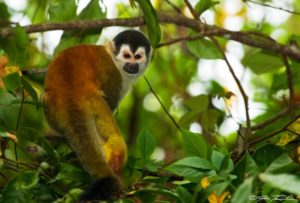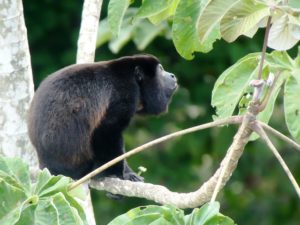One of Costa Rica’s biggest tourist draws is its delightful wildlife – from jewel-colored hummingbirds and vibrant tree frogs to the curious coatimundi. But the real showstoppers in this eco tourism destination are its acrobatic primates. Depending on your itinerary, lucky visitors may spot all four monkey species, including the white-faced, howler, spider and squirrel monkey – all of which inhabit the country’s lowland jungles, tropical dry forest and cloud forest habitats. Learn more about monos, as they’re called in Spanish, and the best spots to see them.
You are going to love staying at one of our beautiful vacation villas!
Central American squirrel monkey

The smallest of Costa Rica’s monkeys, tipping the scales at less than two pounds, is the critically endangered squirrel monkey. Locally known as the mono titi, these adorable creatures can only be observed in two areas: Manuel Antonio and the Osa Peninsula. Thanks to local conservation organizations such as the Manuel Antonio Mono Titi Initiative, populations have held steady in this Central Pacific town, where an estimated 250 monkeys reside in the national park and surrounding rainforest. The protected forests of Corcovado National Park host nearly 3,000 of the black-crowned sub-species. Extremely vocal and social, squirrel monkeys rarely descend to the forest floor and spend most of their time in the treetops eating insects, flowers, nectar and fruits.
White–faced monkeys
This highly adaptable species, also known as the capuchin monkey or white-throated monkey, can be found throughout Costa Rica. They are typically seen in large troops of up to 30 individuals, with mothers toting babies on their backs. True omnivores, white-faced monkeys will feed on just about anything from leaves and fruit to eggs and small lizards. And unlike the squirrel monkey, the capuchin does forage on the forest floor. They communicate by making high-pitched squeaks and chatters and have grown accustomed to human presence in their habitat. Two of the best spots for seeing these primates in action are the Caribbean’s Cahuita National Park and Manuel Antonio National Park. As tempting as it may be, please refrain from feeding these monkeys as it inadvertently encourages dependence on people and aggressive behaviors.
Spider monkeys
The spider monkey, or mono arana as it’s called in Costa Rica, is the true acrobat of the primate world. Known for their endearing pot bellies, fuzzy faces and brownish to reddish colored fur, these monkeys can be observed effortlessly swinging through the canopy, thanks to their extraordinarily long prehensile tail, which functions as another arm. Tortuguero, Arenal Volcano National Park, Corcovado and Curu Wildlife Refuge are spider monkey hotspots.

Howler monkeys
That’s not a ghost you hear yowling at 5 o’clock in the morning, those are the tell-tale calls of the mantled howler monkey, a.k.a the mono congo. Perhaps one of the country’s most pervasive species, howlers are a hoot to watch – and listen to! Their deep calls can resonate for up to two miles in the forest, announcing their presence to nearby troops. Preferring leaves, fruit and bark, these primates are herbivores and can weigh up to 20 pounds. They are characterized by their dark black fur and lighter brown “mantle” around their necks. Look for them in and around the dry forests of Santa Rosa National Park, Arenal, Carara National Park and Manuel Antonio.

 +1 888-818-2097
+1 888-818-2097
 +506 8932-4731
+506 8932-4731